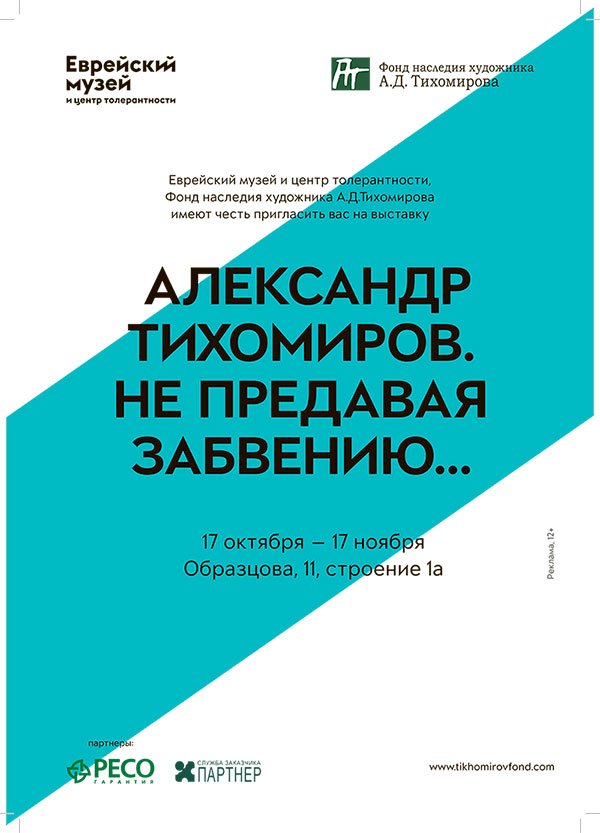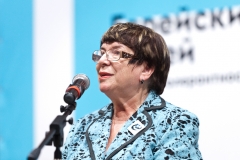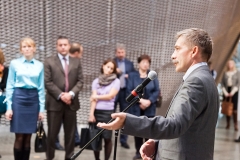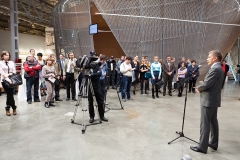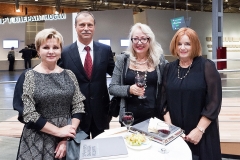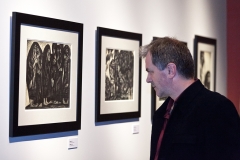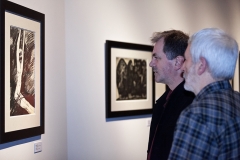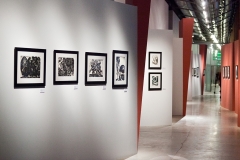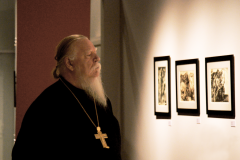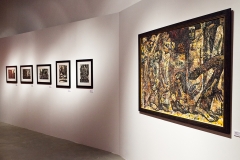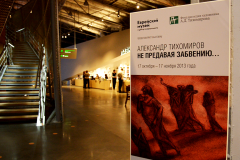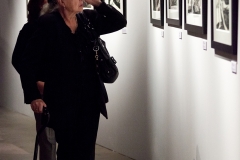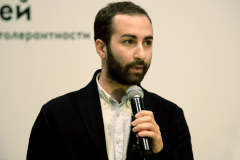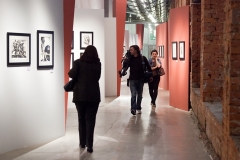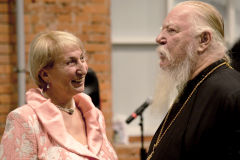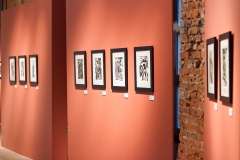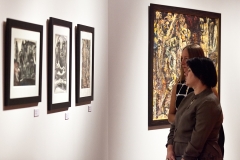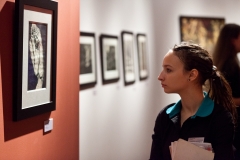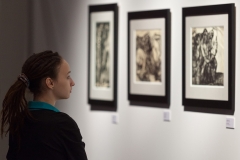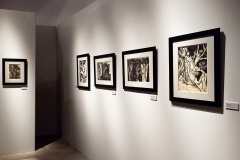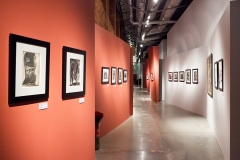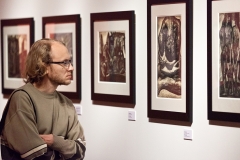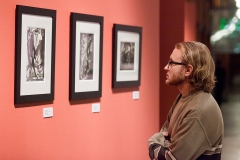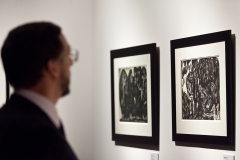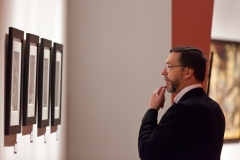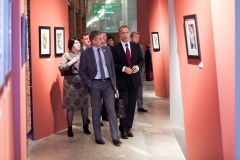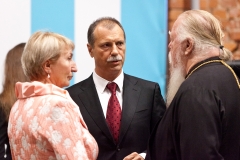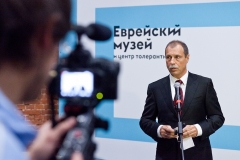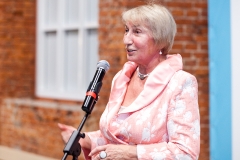«Alexander Tikhomirov. Not condemning to oblivion…» took place on 16 October 2013 in the halls of Jewish Museum and Tolerance Center. It was dedicated to the topic of holocaust.
Born in a family of engineer-constructor, son of the Russian peasants who have moved in 1910s from a village in Kaluzhskaya province into flourishing Baku, Alexander Tikhomirov has from early years been brought up in the atmosphere of a multi-national city. Here people practiced tolerance and goodwill towards representatives of various nationalities and confessions. Suffice to say that when at the end of the XIX century there was not enough money for reconstruction of Alexander Nevsky cathedral, the largest orthodox church in Baku, destroyed by the communists in 1937, – where Alexander Tikhomirov was to be baptised in 1916, – city residents, representing various confessions, donated their own savings, jewellery and argentry for reconstruction.
This proves once again that in multi-national city people paid respect to each other and their neighbours’ religious views.
Nowadays this phenomenon is mentioned by Alexander Ilychevsky in his novel «Pers»: «Rapidly expanding Swedish, German, Polish and Greek colonies, Jewish diaspora, having despised the borders of sedentary life, which only top guild merchants were allowed to cross, – all of these made up aggregate essence of the national phenomenon of our city and induced formation of unprecedented example of cultural and religious tolerance».
Having from his youngest years absorbed such naturally respectful attitude towards surrounding people, Alexander was shocked when his parents told him about capture of Baku by Turks in 1918. Turks were going into rampage, destroying the city and killing whole families of Armenians. This story echoed painfully in his soul and remained present in his memory.
An eye, injured in his younger years, saved him from the battle fields, however, the war has brought him other type of pain and sufferings – death of his young pregnant wife from typhoid, and comprehension of anguish filling up the eyes of widows and mothers asking him to make portraits of their dear ones killed on the battle field. In Baku he created military propaganda posters, portraits of warriors who protected the Motherhood, thus, making his small, but sincere contribution to future Victory. In 1943, upon invitation of his teacher, the artist I.G. Ryzhenko, he joined him in creation of large panel picture «The overthrow of Hitler’s forces in Caucasus» for Baku House of the Red Army and Navy.
In 1944 Tikhomirov was admitted to graphic faculty of the Moscow State Art Institute (as of 1948 named after Surikov), straight onto the third year of studies at the workshop of famous «Russian Cezannist», member of the «Jack of Diamonds» Alexander Alexandrovich Osmyorkin. Tikhomirov quickly entered artistic circles of Moscow. Among first people he has made acquaintance with was an artist B.A. Pinkhasovich, who has been on friendly terms with many other artists, frequently visiting him. Pikhasovichs’ room in the communal flat at Bryusov lane was visited by R. Falk and his students G. Nissky and I. Drize, F. Bogorodsky and E. Simkin.
Efim Davidovich Simkin, who worked on paintings devoted to war theme, went through the war as sergeant of the 226th rifle division near Stalingrad, serving as antitank cannon gunner. He was awarded with battle honours. Sometimes he would speak about war at the table, complaining about pain in the arm which was lost at the front. These war stories have settled in young artist’s memory.
Tikhomirov will remain friends with Simkin and Drize over many years. A booklet of exhibition «Moscow artists: E.D. Simkin» was found in the artist’s archive, with inscription by Efim Davidovich: «To my dear friend – Sasha Tikhomirov with love and for long memory. Efim Simkin. 23/IX 86».
The verge of 1940-1950s is a turning point in the artist’s life. That’s when Tikhomirov abandoned realistic style for good, being more and more influenced by impressionism, which will in the second half of the 1950s become dominant in Tikhomirov’s art. However, «at the same time, during this period of shining, triumphant art Tikhomirov starts referring to themes which will lay a basis of his art over two following decades, testifying intense inner search…» – says art expert E.M. Allenova.
1950s for the artist is a decade rich with creative search – stylistic, compositional, experiments with colour, plastics and form. Works on the theme of the Holocaust, Babi Yar, Auschwitz are standing aside. In those times all talks about horrible shootings in Babi Yar and the death of thousands people have been cut off, information about these events was kept low. In 1943 Ilya Erenburg has asked young poet Lev Ozerov (Goldberg) to go to recently liberated from fascists Kiev and make an essay about the victims of Babi Yar, where many of Ozerov’s friends, friends and acquaintances died. An assay written by him has been published in the «Black Book» and translated into many foreign languages. In March, 1946, !Oktyabr» magazine published Lev Ozerov’s poem «Babi Yar». In 1959 «Literaturnaya gazeta» newspaper published V. Nekrasov’s article about horrible tragedy in Babi Yar, in 1961 – Evgeny Evtushenko’s poem «Babi Yar». In 1966 V. Nekrasov publishes a new article about Babi Yar – «New memorials» – this time in «Decorativnoye iskusstvo» magazine. Based on the chronology of the artist’s works we can say that Tikhomirov has been acquainted with all of these articles, starting with publication in «Oktyabr» magazine, and, most likely, information in the articles has been supported with stories told by the relatives residing in Dnepropetrovsk. Being impressed by what he has read and heard, the artist created his first works on the theme of Holocaust in 1950s. Over three following decades he repeatedly returned to this theme in his art, his last work, «Shadows», was created in 1985.
It takes certain courage and strength to appeal to the theme of genocide. Courage – because the theme of persecution and elimination of the Jews has been banned during Soviet times, strength – because it takes enormous emotional losses to immerse into these events and feel that soul-chilling horror and perplexity invading people condemned to death, that inner scream – why? what for? how is this possible? – breaking out from their chests. Works of the artist – is sympathy expressed the only possible way he could do it those years – through paintings and art. It is a sympathy at the verge of his own heart, going through pain of the other people, taking their sufferings as his own, appeal to the society not to forget about torment of millions of innocently killed and not to let the catastrophe repeat. Thrown back hands, bent heads, open, trembling in a scream mouth, eyes, looking straight forward in a hope for escape from death or figures broken by a fear of inevitable – with pain in each gesture, despair in each movement. Tikhomirov managed to convey these painful feelings in his works. Any of them is a silent scream for help, sympathy, imperishability.
Tikhomirov’s works have laid on the shelf over decades. Moreover, they have not been found after the artist’s death in 1995. Out of the whole series, heirs only knew about two-three graphical works and «Auschwitz» painting (1967). Much later «Memories (Babi Yar)», «Babi Yar» (both created in 1955) have been exhibited and published in the catalogues. But the graphic series itself, consisting of several dozens of works was discovered less than a year ago. It was found by accident when going through archive of Tikhomirov’s daughter, Anna, who followed her father in profession. Among her sketches and graphical sheets there layed a thick file titled «Holocaust», with Tikhomirov’s hand-writing. This discovery gave impuls to organizing and carrying out of the exhibition «Alexander Tikhomirov. Not condemning to oblivion…».
It is not a secret that today’s world is fragile and unstable, it balances on the verge, being torn apart by national conflicts. 70 years on fascism lifts up its head again, waves of terrorism keep expanding. It is extremely necessary and very important that the society unites in fight against this global evil and keeps unperished memory of innocent victims. And the artist Alexander Tikhomirov has made his strong point in this fight.
Ekaterina Gogoleva
About the exhebition
Iosif Kobzon, National Artist of the USSRDeputy of the State Duma in the Federal Assembly of the Russian Federation
 The exhibition of the Russian artist Alexander Dmitrievich Tikhomirov in the Jewish Museum and Center of Tolerancy in Moscow, “Alexander Tikhomirov. In memory of the innocent victims…”, is without question a cultural event.
The exhibition of the Russian artist Alexander Dmitrievich Tikhomirov in the Jewish Museum and Center of Tolerancy in Moscow, “Alexander Tikhomirov. In memory of the innocent victims…”, is without question a cultural event.
A. D. Tikhomirov’s appeal towards the theme of Holocaust, the theme of Catastrophe, Shoah is not accidental. Portrayed examples of ugly manifestations of the inhumane treatment of people left their prints on the artist’s life. He was a contemporary of the shameful event – genocide.
Eradication on a national basis was happening in his native Baku when A. D. Tikhomirov was just a child. His parents, sisters, and he himself survived by pure chance, and the boy only knew of these horrific tragedies because of his relatives, from hearsay.
And after that there was the Second World War, which brought Babi Yar, Auschwitz and other horrifying examples of the gassing and extermination of people to a national principle.
As any war survivor, A. D. Tikhomirov could not stay indifferent to the theme of genocide. And today we see works through which the artist states his opinion about this event for contemporaries and generations to come.
Graphic paintings from the cycle “Babi Yar” and “Auschwitz” remind us again and again of the pain of mankind, which still has not subdued. For us, such reminders are a sharp necessity, because, while the memory of these events lives, there is a possibility that mankind will be able to avoid a second Babi Yar and Auschwitz.
In the given cycle of works, A. D. Tikhomirov determines his position as a citizen, his patriotism and a deep feeling of love towards man, regardless of nationality and religious belief.
It seems that organisers of the exhibition have made an absolutely just decision by allocating the exhibition premises of the Museum of Tolerance for A. D. Tikhomirov’s personal exposition, “Alexander Tikhomirov. In memory of the innocent victims…”
Anatoly Karpov, President of the International World Foundation AssociationDeputy of the State Duma
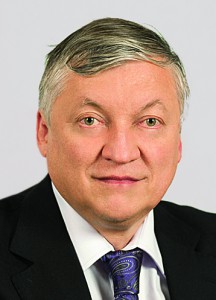 Holocaust as the manifestation of an anti-humane worldview is not an easy theme for an artist. Before addressing it, one ought to live through it and overcome a lot himself. It is hard to acknowledge the fact that one of the greatest tragedies, when whole races with their unique cultures had been erased in the merciless war, was happening in your time.
Holocaust as the manifestation of an anti-humane worldview is not an easy theme for an artist. Before addressing it, one ought to live through it and overcome a lot himself. It is hard to acknowledge the fact that one of the greatest tragedies, when whole races with their unique cultures had been erased in the merciless war, was happening in your time.
The artistic pathway of any artist is highlighted by milestones, which are used by the critics to evaluate his individuality. For Alexander Tikhomirov this would be his studies under Ilya Ryzhenko, student of Repin, in the Baku Arts institute, his work on posters for the Baku Arts circus. Later, once in Moscow, his studies in the Moscow Arts institute of Surikov under Alexander Osmerkin, participant of the “Jack of Diamonds”. Then – many years of working in decorative art and the infamous portrait of Lenin on the building of the Ministry of Foreign Affairs, which was highly praised by his Italian contemporary colleague, Renato Guttuso. All of this existed, but there was also thorough, hidden to onlookers work of the artist, who created, knowing that these works would not be shown in exhibitions and stood an unlikely chance of being published in the art albums. They did not fall into the category of officially accepted art; neither did they fit into what was called the “independent art”.
Alexander Tikhomirov was born in Baku. I have visited the city many times; some of my friends were born there. It is a wonderful place, so unlike any other cities, where people of the most different nationalities and religions have been able to find a home. Baku is one of the most cosmopolitan cities; here, no one culture alone dominates over others. From early childhood, the artist developed certain respect towards people with national and religious roots, which were different to his own. And at the same time as he came across these people in the streets of his native city and engaged in conversation with them, in a different place, these people were methodically and providently eradicated simply due to them representing a certain nationality.
Paintings of Alexander Tikhomirov, dedicated to the memory of innocent victims, make us once again think of the fates of this world. I look upon these works and realize that war destroys those things so close and understandable to me – not only on a cultural level, but also on a general human level. A Muslim or a Buddhist, having looked at these works, would perhaps see something utterly different, close to him and his culture, and yet the pain he would feel would be exactly like mine.
The tragedy of what each nation had to suffer from the genocide is the pain of people, which needs not be explained by words, but for some reason is still incomprehensible to many. Today genocide remains a spiteful topic, independent of the factor of whether it finds its way into the themes of the daily news releases or not.
People on the paintings are seen to shield their faces with their hands, trying to somehow protect themselves from the horror which they are experiencing. But we, those who look at these paintings, must not shut our eyes, in order to prevent ourselves from an indifferent attitude to such events in the world’s society.
Alexander Zvyagintsev, Secretary for the Union of Russian Authors
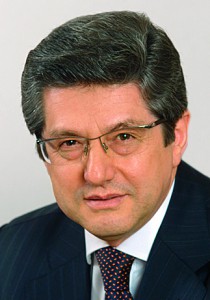 The art of Alexander Dmitrievich Tikhomirov is very expressive and verbal. It tells us about the author, revealing his inner world, circle of interests, attachments, and hobbies, stating his position as a citizen – all in all, speaking about everything, which disturbs and tortures his soul. And still it is evident that the artist retains the will to remain himself, not endeavoring to suit the authorities. He is pernicious and independent, and at times even shocking. Many of his works, painted during the Soviet period, distinctly do not follow the spirit of time as well as the “rules of parties and the government”.
The art of Alexander Dmitrievich Tikhomirov is very expressive and verbal. It tells us about the author, revealing his inner world, circle of interests, attachments, and hobbies, stating his position as a citizen – all in all, speaking about everything, which disturbs and tortures his soul. And still it is evident that the artist retains the will to remain himself, not endeavoring to suit the authorities. He is pernicious and independent, and at times even shocking. Many of his works, painted during the Soviet period, distinctly do not follow the spirit of time as well as the “rules of parties and the government”.
Nevertheless, thanks to the enduring significance of the themes raised by him, the pinching feeling of compassion resounds and pours from many of his works. At that, his compassion is not sentimental or craven, appearing only in the instances of misfortune and desire to distance himself as fast as possible from the heartbreaking emotions at the sight of someone’s grief. The compassion of Tikhomirov is of a different kind. It is of immense sympathy and charismatic honesty. It is not of distant ascertaining. It is heartfelt. It can be seen that this compassion springs from the artist’s tortured soul, which has always been sensitive and open to the sufferings of other beings.
Here I would like to draw special attention to the series of works touching upon the biblical theme of human suffering. The same refers to the series of works titled “Babi Yar”, where the paralysing horror of innocent people doomed to death touches you to the core. The hot, burning compassion with which Tikhomirov, by virtue of his talent, touches upon this ever-present theme, speaks volumes. Obviously, the Babi Yar tragedy keeps beating in his heart as a double-edged splint of a tortured memory, always ready to rupture the aorta.
I grew up in Kiev, and as soon as I started going to school, my mother took me to the Staroe Lukyanovskoe cemetery to see the grave of my great-grandmother, Fekla Dmitrievna. Passing by Babi Yar, she told me: “I could have been the one lying here”. On that morning in September 1941, she was seeing off her Jewish school friends, which were walking in a column, alongside their parents, towards Babi Yar. Near Lvovskaya Square the column’s supervisor, a German guard, asked my mother: “Jewish?” She replied: “No, Russian”. The German yanked her out of the group and pushed her away: “Weg! Leave!” This way, my mother was miraculously saved from sharing the horrible fate of her school friends. My grandmother’s and her turn came later, when they – the Russians and the Ukrainians – were forced into calf carriages and sent off to do labour in Germany under the Fascists. My grandfather, member of the undercover team, was shot. Not only Jews were eliminated in Babi Yar. Later on, 25 thousand prisoners of war, undercovers, communists, members of the Komsomol, gypsies, laid their heads here. That’s where three players of the football team “Dynamo” – participants of the so-called “Death Match” had been shot as well.
In order to better understand and see the scale of this human tragedy, paintings of life, demolished to death, portrayed in Alexander Tikhomirov’s cycle of “Babi Yar”, I’d like to present one story of an eyewitness, a German, the SS soldier and chauffeur Heffer. Under the order of his commander, he travelled to Babi Yar to deliver clothing of killed Jews to the warehouse:
“Stripped Jews were herded into a ditch of approximately 150 metres in length, 30 metres in width and a whole 15 metres in depth… When they approached the edge of the ditch, German policemen grabbed them and laid them over the bodies of the already-shot… All this happened very fast. The motionless bodies laid in neat rows. As soon as a Jew lay down, he was approached by a German policeman with a machine gun, and was shot in the back of the head… Those descending to the bottom of the pit were so horrified by the awful scene before them that they became completely powerless… While some people took off their clothes, and the majority awaited their turn, the atmosphere was filled with an overwhelming noise.
The ditch could not be seen from the place where people were undressing, as it was situated at a distance of approximately 150 metres… In addition to that, it was very windy and cold. Not a shot taking place in the ditch could be heard… More and more masses of people were arriving from the town, and it seemed that they suspected nothing, assuming that they were simply going to be deported, resettled.”
I believe that humanity will never be able to close off its mind to this and forget it! And so Alexander Dmitrievich, having touched upon this tragedy, has done everything he could to forever immortalise the memory of the victims of this terrible war, for the sake of the present and future. So that people always remember the evil, which had befallen us, and so that such a tragedy can never repeat itself.
Unfortunately, we are forced to acknowledge that nowadays the recurrence of the past echoes heavily more and more often and in many countries. We live in an unstable and turbulent world, which becomes more fragile and vulnerable year by year. A new extensive evil has surfaced – terrorism, which has rapidly grown into an independent global power. It has a lot of similarities with Fascism, – ignorance of international and internal legislation, complete obnoxiousness towards morality and the value of a human life. Neither has the brown plague yet sunk into oblivion, as it once seemed in the euphoria of the Great Victory. In several countries, it raises its head again. There is need for a new, firm say in the fight against all this evil – similar to that which was said almost seventy years ago now to German Fascism by the International Nuremberg Military Tribunal, something similar to that which the Russian artist, Alexander Tikhomirov, showed so distinguishably in his works.

